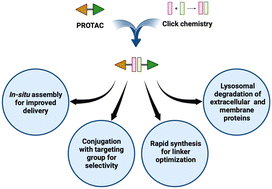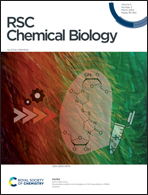Click chemistry in the development of PROTACs
Abstract
Proteolysis-targeting chimeras or PROTACs are hetero-bifunctional molecules designed to mediate the disposal of a target protein via recruitment of the ubiquitination–proteasome degradation machinery. Because of the chimeric nature of such molecules, their synthesis requires a key step of “assembling” whether in the lab or in situ. Furthermore, targeted PROTACs often are hetero-trifunctional and require a second “assembling” step. Click chemistry has the unique advantages of tethering two or more molecular entities of choice under near physiological conditions and therefore has been applied to the development of PROTACs in various ways. This review provides a succinct summary of this field with a critical analysis of various factors that need to be considered for optimal results. Specifically, we examine issues including applications of click chemistry in in situ assembly for improved delivery, conjugation with a targeting group for selectivity, rapid synthesis for linker optimization, and lysosomal degradation of extracellular and membrane-associated proteins. We also examine reaction kinetics issues whenever possible or warranted.



 Please wait while we load your content...
Please wait while we load your content...